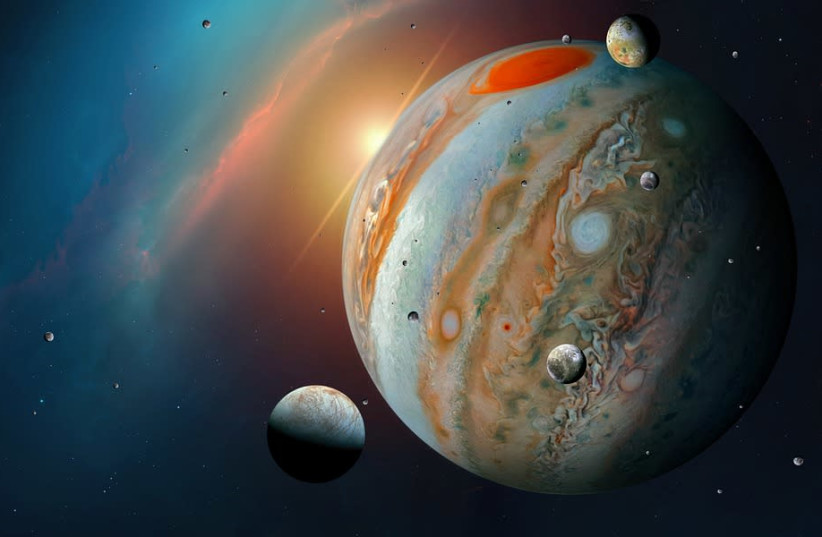NASA's Hubble finds evidence of water vapor on Jupiter's moon, Ganymede
Ganymede is thought to have more water than all of Earth's oceans, but it is trapped deep underneath its frozen crust.
By AARON REICH, Jerusalem Post, JULY 30, 2021

Jupiter, the solar system's largest planet, is seen alongside its moons (illustrative).
(photo credit: PIXABAY)
Scientists have discovered the first ever tangible evidence of water
vapor on Jupiter's moon, Ganymede, giving support to the longstanding
hypothesis that water exists on the moon, and revealing a warmer spot
where water vapor can be released.
The study, whose findings were published in the peer-reviewed academic journal Nature Astronomy, was built on data, new and old, from NASA's Hubble Space Telescope, according to NASA.
The
idea of water being present on Jupiter's moons is nothing new. In fact,
one moon in particular, Europa, having water has been a staple of
science-fiction for many years – most notably in the book and film
adaptation of 2010: Space Odyssey Two by Arthur C. Clark – and later gained greater support after NASA in 2018 discovered water plumes on the moon.
While Europa is rather small, smaller than Earth's moon, fellow Jovian moon Ganymede is the largest moon in the solar system. In fact, it's bigger than the planet Mercury.
It
was long believed based on circumstantial evidence that Ganymede
contained water. Specifically, it was thought that it had more water
than the entirety of Earth's oceans. But as a moon without Earth's warm
atmosphere and temperature, the water in question would all be frozen.
Further, the moon's ocean would not be on the surface at all, but around
100 miles underneath its thick rocky and icy crust.
Hubble Finds Evidence of Water Vapor at Jupiter’s Moon Ganymede, Jul 26, 2021
The evidence dates back to 1998, when Hubble spectrograph images
found evidence of molecular oxygen (O2), but the features observed
didn't match up to pure O2 atmosphere.
It
was first thought that this could be because of high concentration of
atomic oxygen (O), but a 2018 study that was meant to support NASA's
Juno mission found that there was hardly any atomic oxygen in Ganymede's
atmosphere in the slightest.
The
2018 study leader, Lorenz Roth of the KTH Royal Institute of Technology
in Stockholm, Sweden, found that the moon's temperature isn't always as
freezing as previously believed. At some points throughout its day, the
area near the moon's equator, known as the subsolar point, due to it
being where sunlight shines straight down on it, can become warm enough
that its icy surface lets out small amounts of water molecules - and UV
imaging backs this up.
It
should be noted, though, that the subsolar point changes, due to how
Ganymede's orbit works.
Sometimes it's on what is known as the leading
hemisphere, the part of the moon facing Jupiter. But when it's on the
trailing hemisphere, which faces the Sun, there is more water vapor due
to being somewhat warmer. As noted by astronomer Phil Plait, this means there can be a factor of six times as much water vapor when the subsolar point is on the trailing hemisphere.
These findings are especially significant due to the anticipation of the European Space Agency's (ESA) JUpiter ICy moons Explorer (JUICE) mission,
which is set to launch a probe in 2022 to Jupiter, arriving in 2029,
and observe the planet and the three largest Jovian moons, including
Ganymede.
NASA also has plans for the Jovian moons, with a probe dubbed the Europa Clipper set to be launched to the eponymous moon in 2024 and arrive in 2030, to see if the moon can support life.
Please recommend this page & follow the Sputniks Orbit


No comments:
Post a Comment